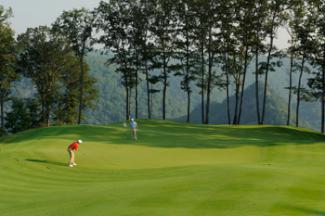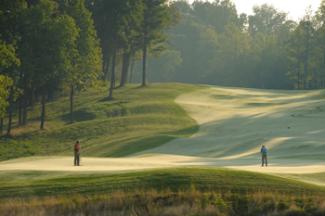Featured Golf News
Primland - A Place of History & Relaxation
The owners of Primland, a sprawling multi-recreational resort located in the Blue Ridge Mountains area of extreme southwestern Virginia, believe the opening of a 72,000-square-foot luxury lodge brings their property firmly into the pantheon of top-level golf and sporting destinations.

The lodge, which features 26 guest rooms that offer nine floor plans, all with exceptional views from the mountaintop retreat, opened in summer after months of painstaking planning and meticulous construction.
"The lodge is the showpiece centerpiece of the property with its many unique features and variety of activities offering relaxation and enjoyment," said Brooks Bradbury, general manager. Amenities range from a spa and ballroom to fine and casual dining. Oh yes, there's also an observatory for viewing the stars that are usually shining brilliantly in the crystal-clear night skies over the mountains.
The lodge was constructed with natural indigenous materials, and the building, along with cottages scattered about the mountainside on the 12,000-acre property, were designed to reflect the architectural style of historic structures in the Virginia mountain area.
Primland, which is owned by the Primat family of Switzerland, has a history that dates back more than 250 years when the then Governor of Virginia, Lord Brooke, gave a 60,000-acre land grant to one William Austin.
Over the years the land was used for many purposes, most notably large-scale timber operations. In the late 1960s, Georgia Southern, which owned the property at the time, began work on the Busted Rock Wilderness Area, offering six to 12-acre residential sites. The company also installed the first power and telephone lines.

Primland Inc. bought the land in 1977 and began to build access roads into the foothills, while developing a market for whole tree chips. By the early 1980s, Primland Kinlin became the largest distributed wood bundled product in its marketplace.
Primland was selected in 1986 as the umbrella name for the property's various companies which, by this time, included a large reserve where visitors could enjoy hunting, sport shooting, fishing and horseback riding.
The Primat family moved into the golf business when they opened the highly acclaimed Highland Course in 2006. Architect Donald Steel designed the layout, which rambles over the mountaintop and around the new lodge and fairway cottages built several years ago. Golf Digest ranked it the best new public course in its category in 2008.
Steel and company have built some 70 new courses in 20 countries since 1987, including three others in the U.S. - Cherokee Plantation in Yemassee, S.C., Carnegie Abbey in Newport, R.I., and The Vineyard on Martha's Vineyard, Mass.

Steel, a Scot who is also an author and editor of several books on golf, created a course that moves easily over the terrain and imbued it with an understated, almost wild elegance befitting the nature around it.
Appropriately, the course starts with a par-5 that slides down a hillside and ends at a green where one is dazzled with majestic views of monumental rock walls called The Pinnacles, and the Dan River Gorge several thousand feet below. One scribe called the valley, "the Grand Canyon with trees."
"Primland sites on top of the world, enjoying scenic views that stretch the vocabulary and with a design that is very different," said Steel of his creation. "There is a sense of remoteness about Primland, a sense of escape that is special. Golf courses have been built in every landscape imaginable, but rarely on mountain peaks."
Just getting to Primland is an experience. After driving along bucolic country roads, one must then journey several miles on dirt roads, past wildlife and native flowering shrubs to reach the clubhouse, perched atop an outcropping that affords another stunning view of the valley.
It is this feeling of tranquility - as well as the world-class golf course, a myriad of other sporting activities and amenities, and lodging that now ranges from rustic to lavish - the owners of Primland believe will attract visitors from around the country and, indeed, the world.
"This is civilization in the wilderness," said Sandy Gardiner, president of The Gardiner Consultancy and a spokesman for the Primat family. "It offers an array of outdoor and indoor activities, from hunting, fishing, golf, sporting clays, tennis, ATV and horseback riding, mountain biking and nature trails to a health spa, fitness center, entertainment center, dining options and, of course, the ultimate star-gazing opportunity.
"The Lodge, its accommodations and facilities, are of great importance in the evolution of Primland as it moves into the luxury resort category," continued Gardiner. "The bulk of our customers will come from a 300-mile radius of the property but, because of some of the unique aspects of the property, such as the telescope which can see 27 million light years into deep space, we have been getting them from further afield."
Original plans were for the construction of a second course on the property to be located in the lowlands area of the vast parcel. In addition, there has been consideration of developing a limited number of parcels of land as building sites for single-family homes. Both plans have been put on hold.
The development of a second course at Primland "is something that has been discussed and therefore remains an option for the future," said Gardiner. On the possibility of residential development, he added, "This would be something that would be determined by market conditions once home sales return to the values in place prior to the economic downturn."
For further information, visit www.primland.com.
This story originally appeared in Cybergolf on November 18, 2009.
John Torsiello is an editor/writer living in Connecticut. He has written extensively about all aspects of the golf industry for a number of national and regional publications. He is a regular contributor to Golf Course Industry, Lawn and Landscape, Golfing, and Fairway Living magazines as well as various online publications. He has strong, ongoing relationships with industry professionals and has worked closely with course owners, architects, developers, course superintendents and general managers around the country. He has won a number of awards for his writing, including first place from the Turf and Ornamental Communicators Association for a piece that appeared in Golf Course Industry magazine.
Story Options
 |
Print this Story |
